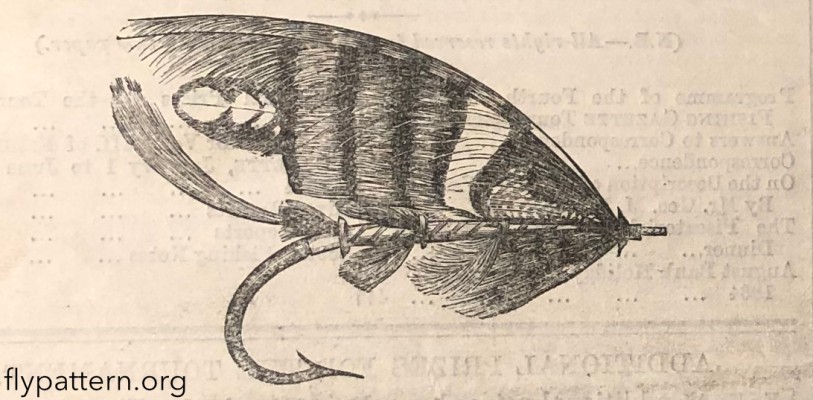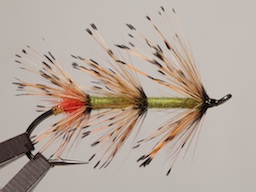| Author | Kelson, George M. |
| Book | The fishing gazette: On the description of salmon flies, Major Traherne's Patterns |
| Book Edition | N/A |
| From "The fishing gazette" - July 26h, 1884 "FOR if it wobbles the least atom there will be no recognition." These words have reminded me of a promise (Feb. 2nd), and I now propose to deal with that subject as we advance. I hope I have already said all that is necessary for the student to be able to make a good selection of hackles, and I suppose he is sufficiently skilful to be able to double them. He should endeavour to arrange his work for the tinsel to guard the feather; so the former should be fixed first, and the latter follow alongside it on the head end of hte hook. Unless the hackle is tightly wound, it will cause the fly to wriggle; and if very loose, not only will it wobble, but skirt the water. Again, if the shaft of the feather - the elastic part which contains a whitish, dry pith - is very stout, the last turn at the throut will create a shoulder, and this must be cured by forming a taper from it with the tying silk. It is a common error to reverse the fibres; not that it signifies much; but they soften and blend with the silk or seal's fur, and play better when pointed to the barb. I need scarcely say that all the downy, flocculent strands should be stripped from the quill end, otherwise they would cling to, torment, and "purse up" the good ones. With an exhibition specimen, the hackles and body may be protected during the afterwork by a length of swan's quill used as a tube, which can easily be displaced by cutting a slit lengthways with a a sharp penknife down the opposite side of the body to that inteded to be shown, beacuse if a single point be cut off the hackle, it could be detected at once under the magnifying glass. Let the hackle be fastened at the header under the hook, then it will not interfere with the "set" of the wings; and after two turns of the tying silk, taper the rest of it with the knife. Neither should treble gut be used on hooks three-quarters of an inch long and under. With it, especially if the angler loops his fly to the single gut cast, the most careful manipulation is required in mounting to secure regularity and balance in the water. In preparing the single gut for this purpose, choose the very best and roundest strands, cut off the length required, and keep it in your mouth to get it throughtly soaked, as hot water injures it. It should be tied perfectly straight under the hook, with one of its ends a trifle in advance, both having already been pared to a fine point, and not applied to a candle to make an excrescence or protrusion. When the gut is thus made soft, the silk, in addition to the following safe-guard, will furrow its way. Use gossamer silk double (I find claret-coloured the best), and wind it as closely, evenly, and tightly as possible; do not allow the silk to twist, for every ridge, however diminutive, is an obstruction. Begin with four or five turns of it spirally along the bare hook, the gut having been dented with the teeth, say every one-sixteenth. Leave the hook bare at present for the wings and head, and also about as much exposed space on the body side of the butt; a touch of shellac varnish over one half hitch will be all that is required. Gossamer silk, as I have said before, is superior to any other for fly-dressers. There is a proper hook attached at will to the cabinet, which will be described in a future issue; saddle the silk twice over it, hold the four pieces at the end to prevent them untwisting, and the process of waxing will be an easy one. Use cobbler's wax, which should be fresh. While the gut is still soft, shape the projecting loop by pushing a stiletto, sold by Wilcox and Gibbs, through it from the under side, pinching the gut with the nails of the thumb and forefinger of the left-hand at the extrinity of the iron. As well as for other obvious reasons, this will bring the gut close and straight at the end of the hook under the wing, where each piece would struggle to get when in use to the detriment of the upper work if neglected now. Salmon fishermen will find this particular probe very service-able not only for this, but for other requisites, and particularly useful while fishing. Turning to this week's illustration, we have another gorgeous and magnificent pattern from our accomplised autocrat, and one well worthy of its scientific denomination. Nephenthe, from the Greek [missing illustration], not, and [missing illustration], pain, is, I believe, used as a figurative and poetical expression for something that affords consolation to the mind; so I take it a Nepenthian is not only to neutralise the sttring of daily disappointments to which all salmon anglers are exposed, but to compensate them, as well as to soothe their misfortunes. Happily they are not born without feelings, and, with due respect to the honoured opinion of Wellington - an opinion which might touch into sympathy even the coldest nature - to them a victory is not the saddest of all things after defeat. Who was it that wrote, "A victory is doubled if the achiever brings home full numbers"? Surely it is a triumph for a gentleman to set out late one afternoon, and catch in well-trashed pools more salmon than one man could carry home. This fortune, followed by the misfortune of losing the fly in the fifth fish, was an adventure last week of Col. Richardson's on the Tweed, and one, with his permission, well worth recording. "I shall never forget the famous Nepenthian" he writes: "Do please make me another, &c." These two pools had been worked by well-known anglers; but in the whirligig of Time, is it not curious how the see-saw of Fashion is strikingly illustrated - coaxed into swing by the winning, wheedling ways of one or another of our tiptop and meritorious members to picture the beatuy and the outcome of the experience? The Colonel's memory of the Nepenthian now is uncommonly like moonlight, - only reflected rays from a light no longer seen; however, it is pleasant sometimes to rake up the past, and carry one's thoughts back; for remembrance, unlike expectation so often defeated, is the only Paradise out of which we cannot be driven away. As we have the illustration I can describe the fly. Tag: Gold twist and gold silk, (same shade as toppings). Tail: Topping and two red crows, as placed. Butt: White ostrich herl, dyed the same colour as dark blue chatterer. Body: In three equal sections. The first light blue silk, same shade as light blue chatterer, with four dark chatterer feathers, as illustrated, back to back and butted with the same coloured herl as before. The middle division, light orange silk, the same shade as the toucan above and below, and butted similarly. The rest, red orange silk, resembling in tint of the three red crow's feathers situated on either side as engraved, from under the throat. Throuth: Red macaw. Ribbed: Oval gold tinsel. Wings: Six tippets, back to back, with two jungle projecting. Cheeks: Summer duck extended, and blue chatterer, two strips golden pheasant tail above, with topping over Horns: Red macaw. Head: Blue herl, as above mentioned. |
|
| Tags | traherne, kelson, fishinggazette, |
Material
- Tag: Gold twist and gold silk, (same shade as toppings)
- Tail: Topping and two red crows, as placed
- Butt: White ostrich herl, dyed the same colour as dark blue chatterer
- Body: In three equal sections. The first light blue silk, same shade as light blue chatterer, with four dark chatterer feathers, as illustrated, back to back and butted with the same coloured herl as before. The middle division, light orange silk, the same shade as the toucan above and below, and butted similarly. The rest, red orange silk, resembling in tint of the three red crow's feathers situated on either side as engraved, from under the throat
- Throath: Red macaw
- Ribbed: Oval gold tinsel
- Wings: Six tippets, back to back, with two jungle projecting
- Cheeks: Summer duck extended, and blue chatterer, two strips golden pheasant tail above, with topping over
- Horns: Red macaw
- Head: Blue herl, as above mentioned.

